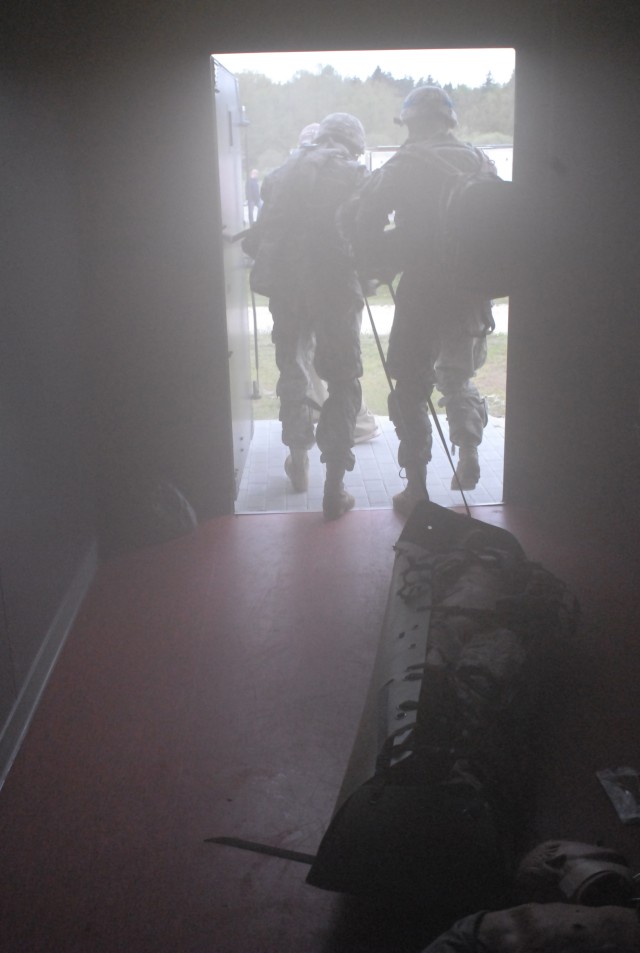VILSECK, Germany - Imagine treating your fellow wounded soldier in a smoky cave lit by the occasional flash of a strobe light, trying not to slip in pools of blood all while machine gun fire bounces off the walls.
Welcome to the Combat Medic Advanced Skills Training at the Medical Simulation Training Center at the Joint Multinational Training Command (JMTC) in Grafenwoehr, Germany.
"We just can't replicate this training anywhere else, and I think it [the training] is a good thing," said 1st Sgt. Jason Brooks, Charlie Company, 173rd Brigade Support Battalion based in Bamberg, Germany.
Brooks observed 23 of his company's combat medics, as they participated in a mass casualty exercise on May 5, in preparation for an upcoming deployment to Afghanistan.
"The days of the throwing a live soldier out in the field and putting some tape on him and telling him to shut up... those days are over, "said Joe Aubihl, JMTC instructor and Former Army Combat Medic. " "Having a soldier drawing a medical scenario card and acting out the symptoms of an illness or injury for a battle buddy to treat are over."
Life-sized, computer-monitored mannequins connected to a power and fluid supply, make the training realistic. The mannequins appear life-life, breathing and bleeding. They even respond to medications pushed to relieve symptoms, which allows the medics to react to the injuries sustained in combat. Each mannequin has different injuries, so the necessary care and treatment of each varies, and they live or die based on the quality of the care administered.
"They actually have to get in there and check the pulses and do interventions themselves," said Brooks. "Any interventions they do for the casualty, if they do it right the casualty will get better- if they do it incorrectly, the casualty's condition can worsen and lead to the casualty dying."
"We like to push to the Soldiers that time is what kills casualties down range," Aubihl said. "We try and give them a sense of urgency to bring the time down to a 20 minute window."
Soldiers are encouraged to treat patients within the first 60 minutes after the occurrence of multi-system trauma. Chances of survival are better if they receive care within the first hour after a severe injury.
Soldiers begin the training by completing the "care under fire phase," in which the medic must properly apply the tourniquet and then drag a 175-pound mannequin several yards to a metal shipping container simulating a cave, like those commonly found in the countryside of Afghanistan.
"You shut the door and it's dark," Aubihl said. "It takes the medics a while to adjust and sometimes we have people running into the walls, but eventually they get used to the light."
In the cave, medics are hit with every-day combat related scenarios, from bleeding gunshot wounds to airway blockages.
"It's pretty confusing at first but you just have to maintain your bearing and focus on your job at hand, which is to make sure people don't die," said Pvt. 1st Class Allen Cote, a 173rd medic who completed the training.
Cote, along with his partner, Sgt. James Halliburton, low crawled to the patients in need and quickly began assessing the situation.
"Here, you are going to make mistakes," Halliburton said of the training, adding that the training allows him and other medics to concentrate on mistakes made to get better experience for the battlefield.
In the final phase of the training, battlefield casualty evacuation, Soldiers drag the casualty to a secured area and perform a 9-line MEDEVAC report.
"We feel extremely fortunate that we're able to train here at the JMTC," said Lt. Col. Curtis Johnson, battalion commander. "Our Soldiers have learned a lot, and this training will be extremely helpful when they hit boots on ground."
About 50 percent of his Soldiers will be deploying for the first time, Johnson said.






Social Sharing